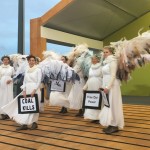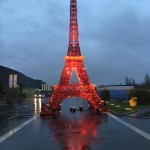By Jeanette Fitzsimons
Cross-posted from Coal Action Network Aotearoa
Why would Fonterra spend several million dollars on a process lasting nearly a year, seeking planning consent for a huge new milk drier that it knows will never be built? Perhaps that’s not a lot of money to them – after all, one million is only three months’ salary for their CEO.
Fonterra’s proposed Studholme project, just outside of Waimate in South Canterbury, would see two new spray driers powered by two immense coal boilers – one 65MW, the other 50.
 This is the biggest new coal burning project in the country, with the hearing happening just as our Minister for Climate Change is about to travel to New York to sign the Paris agreement where we undertook to reduce our greenhouse emissions a totally inadequate 11% below 1990 levels. (It’s even more inadequate when creative accounting turns this into more like +10%).
This is the biggest new coal burning project in the country, with the hearing happening just as our Minister for Climate Change is about to travel to New York to sign the Paris agreement where we undertook to reduce our greenhouse emissions a totally inadequate 11% below 1990 levels. (It’s even more inadequate when creative accounting turns this into more like +10%).
Fonterra is already the second biggest coal burner in the country and grew its coal use by 38% between 2008-2013. They pay lip service to climate change but in practice are totally wedded to coal. Continue reading “Fonterra’s coal-fired climate folly”


 What can I add to the millions of words in dozens of languages that have already been written by the thousands of journalists and commentators around the Paris Agreement? We now have a globally binding agreement that really looks like it could curtail the use of a fuel that has been central to our way of life for more than 150 years.
What can I add to the millions of words in dozens of languages that have already been written by the thousands of journalists and commentators around the Paris Agreement? We now have a globally binding agreement that really looks like it could curtail the use of a fuel that has been central to our way of life for more than 150 years. One of the most beautiful things I saw on my facebook feed last week were some angels at Republique, the scene of the attacks last month. Those same angels appeared at the entrance to the UN zone at the climate talks out at Le Bourget the other day as we walked into the centre. Today it was the Greenpeace polar bear, Aurora, roaring at everyone. But whatever is set up to amuse us on the way in, there’s no getting around it: we’re heading to the pointy end of the Paris agreement, and it’s no longer really about pictures. It’s all about words. The text.
One of the most beautiful things I saw on my facebook feed last week were some angels at Republique, the scene of the attacks last month. Those same angels appeared at the entrance to the UN zone at the climate talks out at Le Bourget the other day as we walked into the centre. Today it was the Greenpeace polar bear, Aurora, roaring at everyone. But whatever is set up to amuse us on the way in, there’s no getting around it: we’re heading to the pointy end of the Paris agreement, and it’s no longer really about pictures. It’s all about words. The text. I’ve been in Paris for over a week now, and the speed at which everything goes past, including time, is frightening. I think the 40,000 expected have now all arrived. I’m getting worried the only Eiffel Tower I’ll see is the one made of red folding chairs at the end of the “Champs Elysee” at the meeting.
I’ve been in Paris for over a week now, and the speed at which everything goes past, including time, is frightening. I think the 40,000 expected have now all arrived. I’m getting worried the only Eiffel Tower I’ll see is the one made of red folding chairs at the end of the “Champs Elysee” at the meeting.
You must be logged in to post a comment.